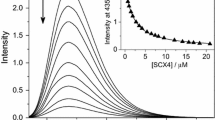Abstract
Interactions involving calixarene and its derivatives are of major importance due to their widespread applications as unique hosts. Fluorescence from a common probe pyrene is used to study interactions involving calix[4]resorcinarene [1a] and its tetra-morpholine derivative [1b] in 1 M aqueous NaOH. These compounds efficiently quench the pyrene fluorescence. A comparison with the fluorescence quenching behavior of N-methylmorpholine clearly indicates the presence of long-range interactions involving 1a and 1b; the interactions are specific to the calixarene molecular framework. This is not the case for a tetra-nitro-substituted calix[4]arene [2b], an electron/charge acceptor quencher, as p-nitrophenol also shows similar interactions with pyrene. Effectiveness of cesium as the quencher of pyrene fluorescence is reduced in the presence of electron/charge donating 1b; fluorescence enhancement is observed upon addition of cesium as the concentration of 1b is increased in the solution. The role of calixarene framework in interactions involving such compounds is established.






Similar content being viewed by others
References
Gutsche CD (1989) In: Stoddart JF (ed) Calixarenes: monographs in supramolecular chemistry. Royal Society of Chemistry, London
Aoyama Y, Tanaka Y, Sugahara S (1989) Molecular recognition. 5. Molecular recognition of sugars via hydrogen-bonding interaction with a synthetic polyhydroxy macrocycle. J Am Chem Soc 111:5397–5404
Chawla HM, Srinivas K (1994) Molecular diagnostics: synthesis of new chromogenic calix[8]arenes as potential reagents for detection of amines. J Chem Soc Chem Commun 2593–2594
Kubo Y, Maruyama S, Ohhara N, Nakamura M, Tokita SS (1995) Molecular recognition of butylamines by a binaphthyl-derived chromogenic calix[4]crown. J Chem Soc Chem Commun 1727–1728
Chawla HM, Srinivas K (1996) Synthesis of new chromogenic calixarenes through bisazo biphenyl linkages. J Org Chem 61:8464–8467
Ludwig R (2000) Calixarenes in analytical and separation chemistry. Fresenius J Anal Chem 367:103
Pod’yachev SN, Mustafina AR, Morozov VI, Ivanova EG, Galyametdinov YG, Konovalov AI (2001) Complexation of dialkylaminomethylated calix[4]resorcinarenes with bis-acetonato and salicylaldiminato complexes of Cu(II). Mat Sci Eng C 18:141–145
Venkatesan N (2000) Studies on calixarene based molecular receptors. Ph.D. Thesis, IIT, New Delhi
Diamond D, Mckervey MA (1996) Calixarene-based sensing agents. Chem Soc Rev 25:15–24
Duncan DM, Cockayne JS (2001) Application of calixarene ionophores in PVC based ISEs for uranium detection. Sensors Actuators B 73:228–235
Li D, Yang X, Mc Branch D (1997) Molecular architecture of calixarenes and their self-assembled mono- and multi-layers for nonlinear optical (NLO) applications. Syn Metals 86:1849–1850
Nabok AV, Lavrik NV, Kazantseva ZI, Nesterenko BA, Markovskiy LM (1995) Complexing properties of calix[4]resorcinolarene LB films. Thin Solid Films 259:244–247
Valeur B (2001) Molecular fluorescence: principles and application. Wiley, New York
Birks JB (1970) In: Photophysics of aromatic molecules. Wiley-Interscience, New York
Turro NJ (1991) Modern molecular photochemistry. University Science Books, Sausalito, CA
Gore MG (ed) (2000) In: Spectrophotometry and spectrofluorimetry. Oxford University Press, London
Rettig W, Strehmel B, Schrader S, Seifert H (eds) (1999) In: Applied fluorescence in chemistry, biology, and medicine. Springer, Berlin Heidelberg New York
Guilbault GG (ed) (1990) In: Practical Fluorescence. Marcel Dekker, New York
Wosnick JH, Swager TM (2004) Enhanced fluorescence quenching in receptor-containing conjugated polymers: a calix[4]arene-containing poly(phenylene ethynylene). Chem Commun 2744–2745
Lee JY, Sung KK, Jung JH, Kim JS (2005) Bifunctional fluorescent Calix[4]arene Chemosensor for Both a Cation and an Anion. J Org Chem 70:1463–1466
Inouye M, Hashimoto KI, Isagawa K (1994) Nondestructive detection of acetylcholine in protic media: artificial-signaling acetylcholine receptors. J Am Chem Soc 116:5517–5518
Megyesi M, Biczok L (2006) Considerable fluorescence enhancement upon supramolecular complex formation between berberine and p-sulfonated calixarenes. Chem Phys Lett 424:71–76
Bakirci H, Nau WM (2006) Fluorescence regeneration as a signaling principle for choline and carnitine binding: a refined supramolecular sensor system based on a fluorescent azoalkane. Adv Functional Mater 16:237–242
Kubinyi M, Vidoczy T, Varga O, Nagy K, Bitter I (2005) Absorption and fluorescence spectroscopic study on complexation of oxazine 1 dye by Calix[8]arenesulfonate. Appl Spectrosc 59:134–139
Iki N, Horiuchi T, Oka H, Koyama K, Morohashi N, Kabuto C, Miyano S (2001) Energy transfer luminescence of Tb3+ ion complexed with calix[4]arenetetrasulfonate and the thia and sulfonyl analogue. The effect of bridging groups. J Chem Soc Perkin Trans 2:2219–2225
Shi YH, Wang DY, Zhang ZH (1995) Fluorescence enhancement of guests by the formation of inclusion complexes with p-tert-butylcalix[8]arene bearing polyoxyethylene chains in aqueous solution. J Photochem Photobiol A: Chem 91:211–215
Matsushita YI, Takanao M (1993) Synthesis of aminomethylated calix[4]resorcinarenes. Tetrahedron Lett 34:7433–7436
Kumar S, Kurur ND, Chawla HM (2001) Varadarajan, R. A convenient one pot one step synthesis of p-nitrocalixarenes via ipsonitration. Syn Commun 32:775–779
Kumar S (2004) Studies on synthesis and applications of substituted calixarenes, Ph.D. Thesis, IIT, New Delhi
Lakowicz JR (2006) Principles of fluorescence spectroscopy, 3rd edn. Springer, Berlin Heidelberg New York
Knibbe H, Rehm D, Weller A (1968) Intermediates and kinetics of fluorescence quenching by electron transfer. Ber Bunsen-Ges Phys Chem 72:257–263
Rehm D, Weller A (1970) Kinetics of fluorescence quenching by electron and hydrogen-atom transfer. Isr J Chem 8:259–271
Saik V, Goun AA, Fayer MD (2004) Photoinduced electron transfer and geminate recombination for photoexcited acceptors in a pure donor solvent. J Chem Phys 120:9601–9611
Acree WE Jr, Pandey S, Tucker SA, Fetzer JC (1997) Spectrofluorometric analysis of aromatic compounds: review of applicability of nitromethane as a selective fluorescence quenching agent for identification of alternant vs. nonalternant polycyclic aromatic hydrocarbons, polycyclic aromat. Polycyclic Arom Comp 12:71–123
Acknowledgements
We thank the Council of Scientific and Industrial Research, India and Department of Biotechnology, India for senior research fellowships to SP and AB; and Department of Science and Technology, Govt. of India for financial assistance. MA would like to recognize a fellowship from UGC, India.
Author information
Authors and Affiliations
Corresponding authors
Rights and permissions
About this article
Cite this article
Pandey, S., Ali, M., Bishnoi, A. et al. Quenching of Pyrene Fluorescence by Calix[4]arene and Calix[4]resorcinarenes. J Fluoresc 18, 533–539 (2008). https://doi.org/10.1007/s10895-007-0296-8
Received:
Accepted:
Published:
Issue Date:
DOI: https://doi.org/10.1007/s10895-007-0296-8




